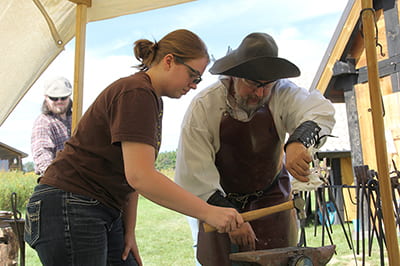History students get hands-on history lesson: Life as a Viking
 Students in Associate Professor Heidi Sherman’s History Capstone Seminar were given the chance to travel back in time when they visited a Viking-age replica farmhouse, called a longhouse, Sept. 12 and 13. The experience gave them the chance to smell the bread baking in a clay oven, hear the clang as a hammer smashes against a scorching-hot piece of iron, and feel the soft thread being woven in a loom just as it would have been hundreds of years ago.
Students in Associate Professor Heidi Sherman’s History Capstone Seminar were given the chance to travel back in time when they visited a Viking-age replica farmhouse, called a longhouse, Sept. 12 and 13. The experience gave them the chance to smell the bread baking in a clay oven, hear the clang as a hammer smashes against a scorching-hot piece of iron, and feel the soft thread being woven in a loom just as it would have been hundreds of years ago.
The longhouse, owned by Owen and Elspeth Christianson, was built in 2011-2012 near Marshfield, Wis.
While at the longhouse, students made food following Viking-age recipes using only ingredients that could have been used in medieval Scandinavia. They were taught blacksmithing techniques and were able to create their own S-hooks out of steel. Students also took part in wire knitting, which was used to create chains for hanging jewelry, and learned to weave on different types of looms.
According to Sherman, several of her students who had gone on the trip last year stated it was the highlight of their college career. One of those students, Ryan Matsen, is now her teaching assistant and was able to go back on the trip this year.
“Of these activities that we were allowed to attempt my personal favorite would have to be blacksmithing as it was so unique to these trips and the fact that by the time we left everyone in the seminar had first hand experience at working metal in ancient ways,” Matsen said.
Many of the students involved in Sherman’s class will go on to be teachers, museum workers, and otherwise involved with the public. This opportunity gives students the chance to take a different approach to learning.
“They’ve got to be able to explain in an engaging way how people did things,” Sherman said. “One of the ways that people get involved and get excited about history is if they’re making something or if they’re doing hands-on things. So I thought it would be fun for the students to go through this process and to figure out how, then they can convert their learning into teaching other people down the road.”
After this experience, students will be creating their own experimental archaeology projects, such as making linseed oil from flax seed or trying to carve a rune stone. Sherman says that it’s not just about the concepts, but about the process they go through.
“I don’t care if the rune stone is perfect,” she said. “I care that the student learns the tools that they need, maybe how to write in runes… He goes through the process and documents it and what he learns from the process.”
The longhouse weekend has provided students with a way to learn about Viking culture that is unique to what they could have learned in the classroom.
“Overall I believe that these trips have been incredibly valuable to help the classes who went on them to gain a better understanding of the past through living like and replicating the processes of the ancient world,” said Matsen.
Story by Katelyn Staaben, editorial intern, Marketing and University Communication
(Click thumbnails to enter slideshow view.)
























Photos by Associate Professor Heidi Sherman



